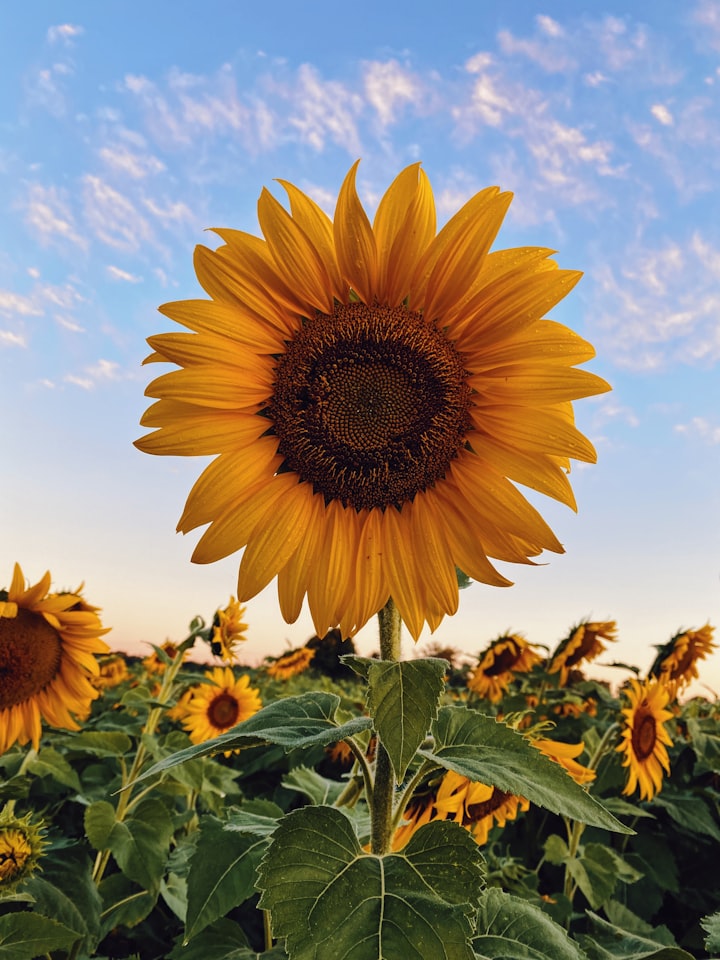
Sunflowers (Helianthus annuus) are vibrant and iconic plants known for their large, bright yellow flowers. Here are some key points about sunflowers:
Appearance: Sunflowers typically have a tall, sturdy stem that can reach heights of 5 to 12 feet (1.5 to 3.5 meters) or even more, depending on the variety. The large flower head consists of yellow petals radiating from a central disk, which is composed of tiny florets.
Habitat: Native to North America, sunflowers are now cultivated worldwide. They thrive in locations with full sun exposure and well-drained soil. Sunflowers are often grown in gardens, agricultural fields, and as ornamental plants.
Cultivation: Sunflowers are annual plants, meaning they complete their life cycle in one growing season. They are relatively easy to grow from seeds, and their rapid growth makes them popular choices for gardening projects.
Uses:
Ornamental: Sunflowers are widely planted for their aesthetic appeal in gardens and landscapes.
Agricultural: Sunflower seeds are rich in oil and are cultivated for various purposes, including producing sunflower oil, which is commonly used in cooking and as a salad dressing. The seeds themselves are also a popular snack and are often added to various dishes.
Wildlife: The seeds attract birds and other wildlife, making sunflowers valuable in supporting local ecosystems.
Symbolism: Sunflowers are often associated with positivity, warmth, and happiness due to their bright and cheery appearance. They are also symbolic of adoration and loyalty.
Sunflower Varieties: There are various sunflower varieties, including those with different flower sizes, colors, and growth habits. Some varieties are bred for specific purposes, such as oil production or ornamental use.
Cultural Significance: Sunflowers have cultural significance in various societies. They have been featured in art, literature, and mythology. In some Native American cultures, sunflowers are considered a symbol of harvest and abundance.
Heliotropism: Young sunflowers exhibit heliotropism, a behavior where the flower heads follow the movement of the sun across the sky. However, as the flowers mature, they tend to face eastward.
Economic Importance: Sunflower cultivation is economically important in many countries for the production of sunflower oil, a widely used cooking oil.
Ecological Benefits: Sunflowers have deep roots that can help break up compacted soil and improve its structure. They also have the ability to absorb heavy metals from the soil, acting as bioaccumulators in phytoremediation projects.
Sunflower Seeds: The seeds of the sunflower are a nutritious snack and are commonly consumed roasted or raw. They are rich in healthy fats, protein, fiber, vitamins (such as vitamin E), and minerals (such as magnesium).
Sunflower Oil: Sunflower oil is a popular cooking oil known for its light flavor and high smoking point. It is commonly used in frying, baking, and as a base for salad dressings.
Health Benefits: Consuming sunflower seeds and their oil may offer health benefits, including cardiovascular health due to their unsaturated fat content, antioxidant properties from vitamin E, and potential anti-inflammatory effects.
Cultural Traditions: In some Native American cultures, sunflowers are of spiritual significance. They are associated with solar deities and are used in ceremonies and rituals.
Art and Literature: Sunflowers have been a popular subject in art, notably in the paintings of Vincent van Gogh, who created a series of works featuring sunflowers. These paintings are celebrated for their vibrant colors and symbolic meaning.
Hybrid Varieties: Plant breeders have developed hybrid sunflower varieties with characteristics such as shorter stature, multiple flowers per stem, and different petal colors, expanding the range of choices for gardeners and commercial growers.
Sunflower Pollination: Sunflowers are pollinated by bees, butterflies, and other insects. Their large and open flower heads make them easily accessible to pollinators, contributing to the ecological balance of the area where they are planted.
Dwarf Sunflowers: In addition to the tall varieties, there are dwarf sunflowers that are more suitable for smaller gardens or containers. These compact plants still produce the characteristic bright flowers but on shorter stems.
Harvesting Sunflower Seeds: Harvesting sunflower seeds is a popular activity, especially in the late summer or fall. Once the flower heads have matured and the seeds are developed, they can be harvested, dried, and roasted for consumption or saved for planting the following year.
Sunflower as a Cover Crop: Sunflowers are sometimes used as cover crops in agricultural practices. Their extensive root system helps prevent soil erosion, and their residue can add organic matter to the soil when the plants are plowed under.
Sunflower Festivals: In some regions, communities celebrate the beauty of sunflowers with festivals. These events often feature art, music, and various activities centered around the flower.
About the Creator
Blog _ Vista
"Crafting compelling narratives and insightful content on our profile. 📖✨ Diving into diverse topics with a blend of passion and precision. Join the conversation, explore ideas, and savor the art of storytelling.






Comments
There are no comments for this story
Be the first to respond and start the conversation.